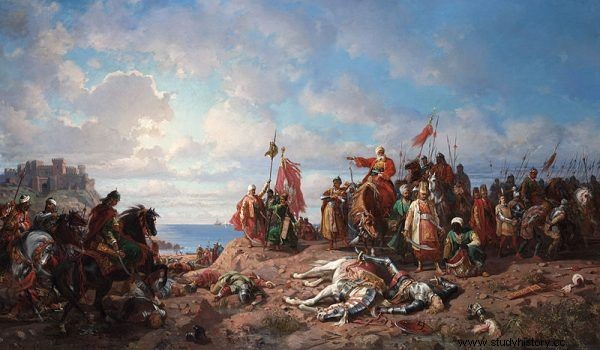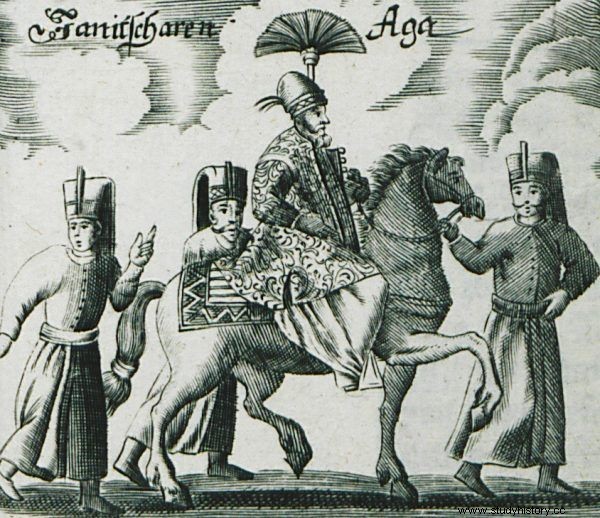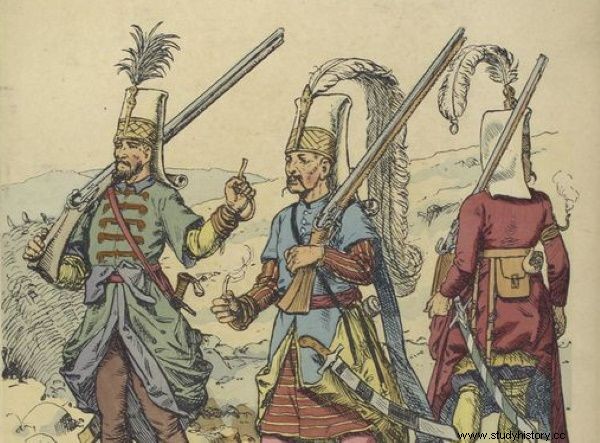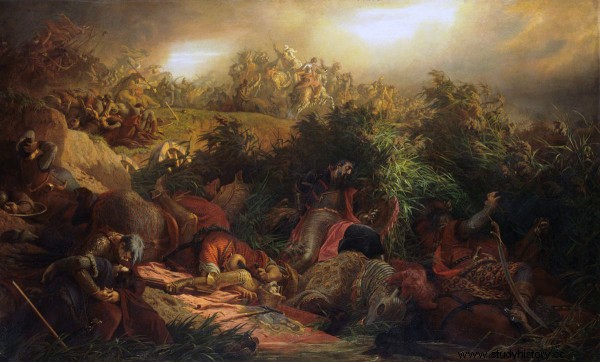For centuries they were the elite of the Turkish armed forces. They were considered the best infantry in the world at that time. This formation of "the most faithful of the faithful" has often been used in the fight against Christians. And yet it was created by ... Christian exiles forcibly taken from their families!
It was November 10, 1444. For several hours, on the plains outside the city of Varna, a fierce battle was fought between the troops of the king of Poland and Hungary, Władysław Jagiellończyk, and the forces of the Turkish sultan, Murad II. Even though the Turks were outnumbered, it seemed the Christians were starting to win. First they repelled the Turkish attack on their right wing. Then a strike at the Christian center pushed the Turks away and forced them to withdraw. The Rumelian army was also dispersed on the Muslim left wing.
When it seemed that victory was at hand, it was a disaster. The young king Władysław decided that it was enough to finish off the opponent . At the head of his court unit, he moved to the command post of the Sultan, protected by the Janissary infantry corps. Heavily armed knights started a charge and forced their way into the ranks of the Janissaries.
However, they did not get distracted. Well trained and disciplined, they withstood the blow and then surrounded their attackers. The horse of the Polish monarch stumbled, and he himself fell to the ground. The Janissaries caught up with him in no time - one of them chopped off his head. The death of the ruler caused panic in the Christian ranks, which fell into disarray. The victorious battle has turned into slaughter…

The Janissaries contributed, among other things, to the Turkish victory in the Battle of Varna in 1444.
The Battle of Varna was one of many clashes in which the Janissaries ensured the victory of the Sultan's army. This elected unit, made up of Christian captives, was one of the best infantry formations in history. For several centuries, its members were feared on the battlefields of Europe and few troops were able to successfully oppose them in combat.
Conquers are the slaves of the winners
Where did the Janissaries come from? Their branch was established in the fourteenth century. According to some, it was created by the Sultan of Orchan, who ruled from 1324 to 1362. It was one of the many military reforms he carried out. According to another version, the roots of the elite unit should be sought during the reign of Orchan's successor, Murad I. It was during his reign in the Ottoman Empire that the custom of transferring to the Port one out of every five prisoners taken on expeditions was established. It was out of them that the Sultan created a selected corps subject only to him.
The name of the formation comes from the Turkish term yeni çeri , meaning "new army". And as the size of the Ottoman army was constantly increasing, it soon turned out that there were too few prisoners for service. An additional source was then used. The influx of candidates for the corps was provided by the forced captive system, called devszirme (i.e. collecting).
This solution was introduced by Murad I, stating that "the conquered are slaves of the victors". What was it about? Here are every few years Christian families living in the Balkans and northern Greece were forcefully taken away from boys aged 7 to 14 and sent to Constantinople . This is what Magdalena Genow writes about it in her book “Bulgaria. Gold and rakija ” :
Dewszirme , or captivity, called by the Bulgarians "bloody tax", took place every few years. Every family had to pay a bloody tax. Only families in which one boy was born and orphans were exempted. [...] The sons of the artisans living in the cities were not welcome in the army as their work might have brought the Empire more tax profits .
In the capital, dislikes were circumcised, converted to Islam, and sent to work on farms of peasants or craftsmen (usually former soldiers) in Anatolia. During their several years of stay, they learned the language, culture and Islamic customs there. Then they returned to the capital and ended up in cadet regiments ( adżemi olan ) with thorough military training.
They were taught discipline and endurance to weather conditions - heat and frost. They were trained to work hard:chopping wood, carrying loads, digging trenches. They learned useful skills:construction, masonry, carpentry. They also practiced the use of various types of weapons:saber, spear, bow, berdysh, ax, and later also firearms.
In the regiments, boys were instilled with obedience, a deep attachment to Islam and absolute loyalty to the Sultan. As a result, the youths became skillful, well-trained soldiers and fanatical followers of the Prophet, attached to their ruler . They lost their original national identity and all emotional ties to their families and communities.
Soldiers' community
After seven years of study in the regiments, a selection took place. The most talented were directed to the personal guard of the Sultan. Left-handed (called salakami) protected the left side of the ruler, and right-handed (spiders) protected his right side. The less talented "recruits" went to the regular Janissary units, and the least promising ones to the auxiliary units:caravans, workshops, kitchens, orchestras.
Those who went to the court had a chance for a real career. Outstanding young men were educated and acquainted with administration and politics. The most talented often reached high positions in the state service, including the position of vizier .
In general, service in the Janissary detachment was prestigious and was a source of pride in the Ottoman society. It even happened that Balkan families bribed Turkish officials leading a captive so that their sons would join the ranks of a prestigious unit. Some Turkish Balkan families even baptized their sons so that they could be subject to devshirme !

The corps commander was Janissary Aga. 17th century drawing.
Young men destined for line service were assigned to units called ortas which we can compare to regiments and which numbered from 100 to 500 soldiers. There were 196 ortos in the Sultan's army. Each was commanded by a colonel - çobaci and the officers were six adabashis . The commander of the entire Janissary corps was Janissary Aga , about which Wacław Potocki wrote in his "War of Khotyn":
Jancharaga sounded in the middle [trimmed] into peacock's down
He will put his fiery regiments at the forefront,
Sam rides a white arabian on the back,
As a comet sparkles among the stars .
Orta was a military branch, but also a military community. Its members lived together, exercised together, and fought together. Each such unit had its own money, to which the money of the killed or deceased comrades went, later allocated to the support of the disabled.
Janissaries could not associate with women, drink alcohol, gamble. In return, they received a regular pay, were exempted from taxes, and when they distinguished themselves in the fight, they were rewarded for their bravery:with money, a promotion, a position in administration or a land grant. Their ministry continued until the age of 45.
“They were a kind of brotherhood. They stood out because they didn't wear beards. They couldn't have families ” - says in the book "Bulgaria. Gold and rakija ” Magdalena Genow. Thanks to this organization, the sultan gained a well-trained, disciplined and obedient group of soldiers on which he could always rely. It was the support of his power, so much so that the Janissaries were called "beloved sons of the Sultan" . Their troops were stationed in the capital and in the most important cities and fortresses of the state.

The armament of the best warriors consisted of sabers, scimitars, bows, and later arquebuses and muskets.
The body grew steadily. In 1527, it had 11,000 soldiers, in 1574 - 21,000, and in 1670 - as many as 48,000. Some authors give even larger numbers. There are many who suggest that at the end of the 17th century there were over 100,000 members of the elite unit!
The best infantry in the world
Janissaries wore no armor, but quilted caftans to keep them from getting hurt. They wore tall white felt caps ( kits ) on their heads ) with a long sleeve falling down the back. Their commander, Janissary aga , it was distinguished by a pointed cap. The armaments of high-class warriors consisted of sabers, scimitars, bows, and later arquebuses and muskets. They handled each of these weapons brilliantly.
For three centuries, the members of the unit were the elite of the Turkish army and its main strike force (along with the heavy cavalry known as spahis ). They shot well and were also effective in close combat. In the attack on their enemies "they threw themselves furiously, like a raging wilderness" . They also performed well in defense, building fortifications, besieging fortresses and fighting in the rolling stock. They were able to face even the heavily armed European knights. No wonder some historians consider them the best infantry in the 16th century.
In their heyday, they contributed to many victories of the Turkish army. Their merit is, among others, the triumphs in the battles of Nikopolis in 1396, Varna in 1444, during the conquest of Constantinople in 1453 and at Mohacs in 1526. This is how the death of King Władysław Jagiellończyk in the Battle of Varna mentioned at the beginning is described in a Turkish chronicle:
In the heart of the cursed king, Satan's temptation overcame him, making him too trusting. In his presumptuousness, considering himself a hero, thought that he would only disperse the troops, and therefore he struck in their center, where Sultan Murad stood . But when he reached the edge of the formation, his horse stumbled and he fell onto his face. There were two Janissaries in this place, and the name of one was Kodża Hyzyr, and he was one of the brave Junaks nearby who cut off the head of the cursed king and carried it to Sultan Murad.
Poles had the opportunity to meet the Janissaries - with varying degrees of success - for example at Cecora in 1620, at Khotyn in 1621, at Kamieniec Podolski in 1672 and 1688, and of course at Vienna in 1683.
However, the successes and high position of the Janissaries eventually led to their downfall. The demand for new soldiers and the attractiveness of the service meant that Turkish volunteers were accepted into the ranks of the corps. These were not so ruthlessly obedient and disciplined. With time, the strict rules of barracks life and celibacy also ceased to apply.
The corps began to meddle in and participate in politics, putting pressure on the rulers. He also fought to maintain his position, demanding from time to time an increase in salaries and pensions, which was a significant burden for the state budget.
When the sultans did not want to yield, there were rebellions and palace upheavals. Reluctant to submit, the rulers often lost their throne in them. Such was the fate of, for example, Osman II, who, after the defeat at Khotyn in 1621, of which he accused the Janissaries, wanted to limit their influence and then liquidate the formation. Upon hearing of this, the guards started a revolt, kidnapped the Sultan and strangled him ...

The victory of the Turks at Mohacz in 1526 was also due to the Janissaries.
The dissolution of the rebel corps was successfully carried out only by Mahmud II. It happened in 1826. After failing to suppress the Greek uprising, he made the decision to reform the army on a European model. One of the elements of the modernization process was the disappearance of the Janissaries.
Mindful of his previous experiences, the Sultan prepared himself accordingly. When after the promulgation of his edict dissolving the corps, there was a rebellion, the loyal rulers of the unit ( spahisi and artillery) repelled the Janissaries. They were driven back to the barracks where they were bombed and burned . Most of the members of the formation died. Those who managed to survive were publicly executed. After five hundred years, the history of the Janissaries was over. Today only a legend remains - and the opinion of the best infantry in the world, at which half of Europe trembled.
